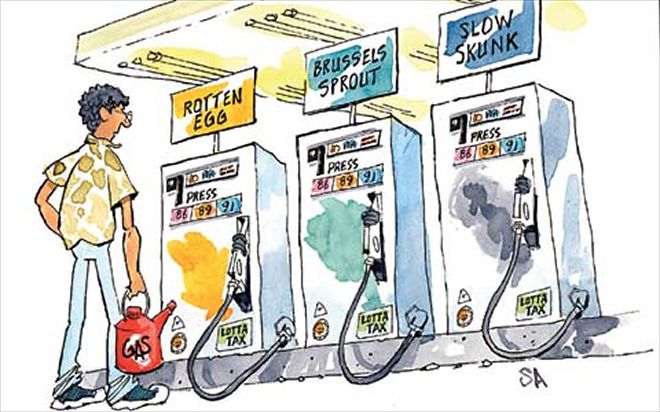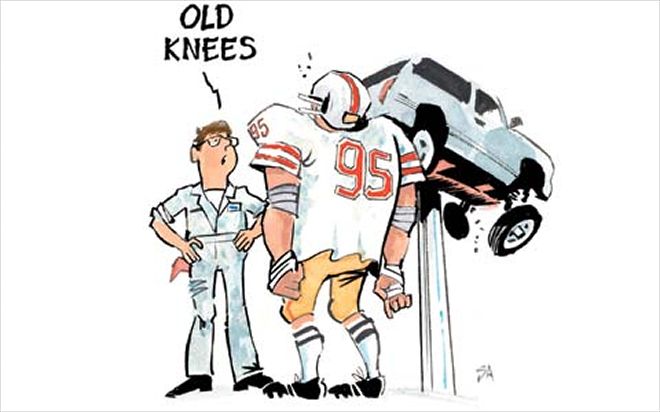
| 163 0407 Ttg01 Z
Fuel Economy QuandaryQ:I have a 1995 Chevy truck with 232,000 miles on it. I keep a close watch on my mileage. It normally runs about 14-15 mpg, but I noticed a drop to around 12.5, and now it's down to 11 mpg. This all happened in less than two months. I change the oil regularly, and the main use of this truck is for commuting to work, which is about 25 miles round trip. What could be causing the drop in fuel economy?
A:There are all kinds of possible causes for a decrease in fuel economy, but we should note it's not always an easy job to accurately determine miles per gallon. With that said, we'll assume you've been testing your fuel use uniformly by using the same grade fuel, maintaining the same speeds, rate of acceleration, braking, and so forth, while keeping relevant mechanical aspects of the vehicle at a constant. Items such as the air-conditioning being on or off, low tire pressure, or even leaving a window down can have an effect on the final results. So, you've lost three or four mpg recently: The first thing to inspect on a fuel-injected engine is the oxygen sensor. This reads the O2 content of the exhaust and relays the information to the Powertrain Control Module, which incorporates this data to determine the proper amount of fuel delivery to the engine through the fuel injectors. The whole idea is to maintain an optimum air/fuel ratio (14.7:1) to keep the mpg high and emissions output low. Oxygen sensors don't last forever, and they can get lazy as time goes on. A faulty sensor may have a significant effect on fuel economy prior to setting a trouble code and lighting up the "Check Engine" or "Service Engine Soon" indicator. You're going to have to get your Chevy to a qualified technician with the proper equipment and knowledge to accurately test the performance of the sensor. If it checks out, the technician may find another cause by evaluating data with the appropriate scan tool. But keep in mind that with over 200,000 miles on the odometer, the diagnosis may turn up a few internal mechanical shortcomings.

| 163 0407 Ttg02 Z
Baffling Muffler ProblemQ:I have a 1999 GMC Sierra extended-cab 4x4 with a 4.8-liter engine. I recently removed the stock muffler and installed a Flowmaster unit, hoping to decrease the backpressure to get better gas mileage and power. However, the opposite has happened to the mileage. Since installing the muffler my gas mileage has dropped about three to four mpg. Can you tell me why the mileage dropped?
A:As odd as it might sound, the answer may be psychological. We've heard of a few cases where fuel economy dropped after the installation of a performance-exhaust product, simply due to the driver going harder on the accelerator in response to the high-performance exhaust note. My first suggestion is to give Flowmaster tech support a call (800/544-4761). Another cause could be the installation of a muffler that wasn't quite right for your particular application. For example, the 40 Series is one of the loudest and least-expensive mufflers it offers, whereas the 50 Series is more attuned to a light-truck or SUV application. Exhaust backpressure is an important catalyst in performance and fuel economy, and each muffler design utilizes unique deflection and flow characteristics. The loss of fuel economy also could be the result of improper installation, a need for additional exhaust system modifications, or perhaps something unrelated to the new muffler.
Fuel in CrankcaseQ:A couple of friends own 2001 Ram 1500s, one with the 5.9-liter V-8 and one with the 3.9-liter V-6. Fuel is getting into the V-8's crankcase. You can drive 200-300 miles, and it might add a quarter inch or more on the dipstick. Chrysler says the problem is low-grade fuel. The V-6 started rattling, and a dealer told him the cause is also cheap fuel. Could it be the injectors are leaking down? Have you heard of this problem before?
A:Let's start with the V-8 Ram. Maybe there's a communication breakdown with the Dodge service department. Assuming the engine is running well enough to complete the combustion process in all eight cylinders, it's possible that a leaking fuel injector could bleed fuel down past the piston rings and into the crankcase after the engine is shut down. But this would be a very small amount, which may produce a hard-start condition and possibly foul out a spark plug, causing a misfire. Fuel in the crankcase was a problem with older engines that used mechanical fuel pumps, as opposed to the more modern use of an electric pump in the fuel tank. In those past cases, the pump was mounted to the engine and a failure could actually pump fuel directly into the crankcase. Make sure your friend is checking the oil level correctly and in a uniform manner. This means having the engine at normal operating temperature, with the truck on a level surface, and waiting about five minutes after shutting down the engine before pulling the dipstick. This allows the oil to work its way back down into the oilpan. Then he has to check it exactly the same way the next time around. The rattling from the 3.9-liter V-6, which I'll assume to be a spark knock or ping, can be caused by poor-quality fuel. You can determine this yourself by trying different fuel from different companies and perhaps going up a grade in octane rating. If that doesn't help, get it back to the service department and have them double-check the PCM programming. There are updated calibrations for spark-knock conditions depending on the production date of the vehicle in question.

| 163 0407 Ttg03 Z
Chevy Hub WearQ:I was wondering if you've heard many complaints concerning the 1999 Chevy Blazer. I purchased mine brand-new and put 30,000 miles on it, and already the front hubs, ball joints, and so forth need to be replaced. This vehicle has never been off-road. Has there been a recall of some kind?
A:Ball joints and hubs are somewhat common problems on a Blazer, especially the lower ball joints on 4x4 models. They seem to wear out before most other parts, and you'll notice a clunk from the front end when they get sloppy. A frequent cause is a simple lack of lubrication. Owners often assume a newer car or truck uses sealed, maintenance-free suspension parts; therefore vehicles similar to your Chevy, which require periodic lubrication, often go without. Always replace worn ball joints before it becomes a safety issue, and be sure to follow up with a wheel alignment. There was a ball-joint-related recall on earlier Blazers, but nothing applies for the 1999 model year. The front hubs mount the wheels to the suspension by means of a sealed, maintenance-free bearing. Hub failure generally begins with a moaning or groaning noise on the road, often, but not always, originating from an impact with a curb or pothole. No recalls or service bulletins help with this one, either.
Flipping the SwitchQ:I have a 1996 Ford F-150 with only 38,000 miles on it, which I don't drive often. Recently, the secondary fuel tank stopped kicking in when the tank switch was changed over. Could you explain what might cause this problem?
A:Diagnosing the problem should start at the fuel-tank selector switch itself. This switch directs power from the fuel-pump relay to the fuel pump in either the front or rear fuel tank and simultaneously connects the fuel gauge in the instrument panel with the front or rear fuel-tank sending unit. The most common cause may be the fuel-tank selector switch, but it's never a good idea to replace parts before confirming the failure. To help identify the problem, take note of exactly what happens when you switch to the other tank prior to testing the circuits in question. Does that tank's fuel pump not come on, does the fuel gauge not read correctly, or do both occur? The problem may lie at the switch, pump, sender, and/or the wiring and connections in a number of related circuits.
SmartTrac vs. AutoTracQ:I own a 2002 Olds Bravada with SmartTrac. My other truck is a 2003 GMC 1500 with AutoTrac. The Bravada is my first all-wheel-drive truck, but I've had many 4x4 trucks in the past. The system on the Olds seems downright scary when driving in the snow and on ice. I've had it checked many times, and I'm always told it's working normally. In four-wheel-drive mode on the GMC, it works perfectly in snow, and even in all-wheel-drive mode it's all right. The Bravada, on the other hand, makes me nervous when the weather gets bad. It seems that it can't make up its mind to be in two- or four-wheel drive.
A:The Bravada's SmartTrac is a fully automatic four-wheel-drive system with a one-speed transfer case. Under normal driving conditions, it directs full torque to the rear wheels. When sensors detect a difference in front and rear propeller-shaft speeds due to wheelspin from poor traction, the control module quickly commands the transfer case to add variable torque to the front wheels as needed. Once the vehicle regains traction, it goes right back to rear-wheel drive. The GMC Sierra, equipped with AutoTrac, works differently. This has a two-speed transfer case with a much-needed 4WD low-range for off-road applications. It also includes a selector switch, giving you the options of AWD, 2-Hi, 4-Hi, or 4-Lo. The AWD setting works like SmartTrac, automatically applying variable four-wheel drive when needed, whereas 2-Hi drives only the rear wheels and eliminates automatic engagement, 4-Hi gives fully engaged 4WD for higher speeds, and 4-Lo puts the transfer case in low-range to get through the toughest spots on the trail. The advantage of SmartTrac and AutoTrac's AWD setting is improved fuel economy while automatically supplying all-wheel drive without any intervention by the driver. Most agree that you won't get the same level of traction as 4-Hi or 4-Lo full engagement. Assuming your Bravada's drivetrain is functioning correctly and the suspension is in good condition, keep in mind you're dealing with two completely different vehicles. The structural characteristics, along with tire size and design, are going to significantly affect handling ability in poor traction conditions. With the information at hand, my only suggestion would be to install more aggressive all-weather or snow tires if the climate warrants. In addition, be sure to maintain correct tire pressure at all times.
Drivetrain BacklashQ:I haven't been able to get a straight answer from GM or a transmission shop on how to resolve a nagging problem with drivetrain noise coming from my 1995 GMC Sonoma 4x4 with a five-speed manual transmission (97K miles). My dealer test drove it and gave me a standard answer: "It's normal." A local transmission-repair shop told me they would look at it, but couldn't guarantee that they could eliminate the noise. The best way I can describe the noise is clucking and clanking while shifting. The problem is worse during the summer and after extended highway use. All drivetrain fluid levels have been checked, and there are no worn out U-joints.
A:As you've heard before, a certain amount of driveline clunk can be considered normal, especially on a 4x4. You don't want to invest a lot of money attempting to cure the problem on an older, high-mileage compact pickup. Between the many parts which incorporate a drivetrain, from the crankshaft to the axles, are specified clearances. These clearances add up to a normal amount of freeplay or slack. While in gear under acceleration, the freeplay is taken up in one direction. When you let off the gas or depress the clutch pedal, the drivetrain is twisted in the opposite direction. This is when all of the parts come together once again with an irritating clunk, and vice versa when you put it back in gear and hit the gas. After 97,000 miles, normal wear will add to the clearances, and in turn amplify the clunk. You want a thorough inspection of the front- and rear-axle assemblies, and also be sure all engine, transmission, and transfer-case mounts are secure. I would be hesitant to invest in a teardown of the transmission or transfer case without a clear indication of an internal failure.
Pint-Sized PerfumeQ:I recently smelled antifreeze coming from my 2001 Chevy Tracker ZR2 and took it to my local Chevy dealer, who replaced a hose. Later, I could still smell it, and when I took it back a second time, they couldn't find anything wrong.
A:There are several possible sources. I've seen cases where owners return to the shop after a coolant-system repair due to a residual odor. There may have been coolant spilled during the hose replacement, which has now accumulated elsewhere on the engine. It can take a long time to evaporate, and you're going to notice the smell until it does. There could be another leak in the system that wasn't picked up during the first repair. Also, it's fairly common for the upper radiator hose to leak at the aluminum thermostat housing, and a repeat of the same leak is feasible if corrosion buildup on the housing wasn't thoroughly cleaned. In extreme cases, replacement may be required. If the coolant aroma is still present after another week of driving, take it back. First take a look under the vehicle, and if there's any coolant on the garage floor, the location in relation to the engine compartment may be helpful. Next time you go to the dealer, ask them to install a coolant dye in the system if the leak is too small for them to locate with a pressure test.
How To Reach AlexIf you have a technical question regarding your pickup, SUV, or van, feel free to contact Alex, a master technician with the National Institute for Automotive Service Excellence. Send a letter to him in care of Truck Trend Garage, 831 S. Douglas Street, El Segundo, CA 90245, or e-mail us at
[email protected]. Please include the VIN with your question. Due to the volume of questions received every month, we cannot guarantee that everyone's question will be personally answered or will appear in the magazine.
Can't wait for help with a problem you're having with your Truck or SUV? Ask the expert we trust here at Truck Trend Garage--visit Alex Steele at www.RealWorldAutomotive.com.
 | 163 0407 Ttg01 Z
Fuel Economy Quandary
| 163 0407 Ttg01 Z
Fuel Economy Quandary | 163 0407 Ttg02 Z
Baffling Muffler Problem
| 163 0407 Ttg02 Z
Baffling Muffler Problem | 163 0407 Ttg03 Z
Chevy Hub Wear
| 163 0407 Ttg03 Z
Chevy Hub Wear